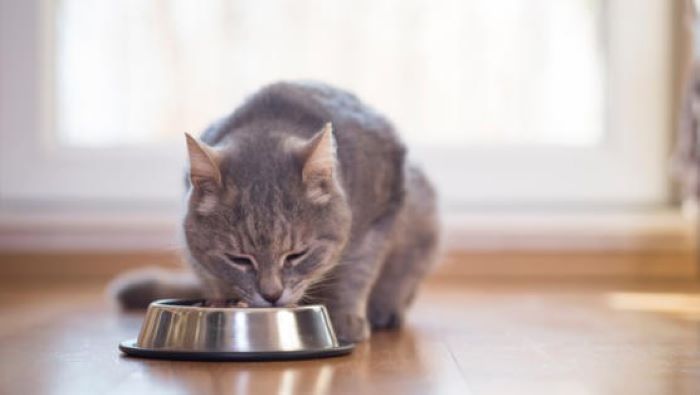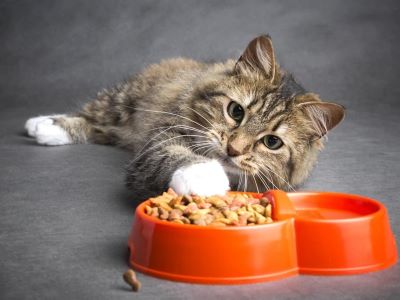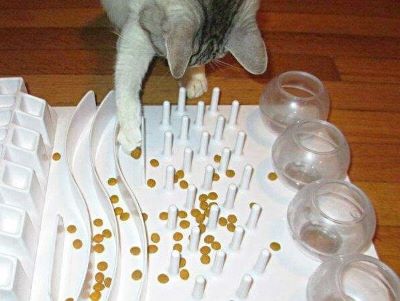Witnessing your cat’s vomit is never a delightful sight. Not only do you have to tackle the cleanup duty, but it also triggers worry within you.

However, vomiting isn’t always a cause for alarm, especially if there aren’t any other concerning signs.
If your cat is tossing up food but acting perfectly normal, chances are everything is alright. It could be a harmless hairball or a case of devouring dinner too eagerly!
But as a devoted cat parent, you still desire to delve into the reasons behind a cat’s upset stomach and learn how you can offer help.
Why Is My Cat Throwing up Food but Acting Normal?
There are various reasons why a cat might be vomiting food but acting utterly normal after that.
But, if throwing up is followed by loss of appetite, lethargy, or weight loss, then you should be alarmed. Let’s find out more about what causes vomiting:
1. Food Allergy
“A food allergy refers to an adverse reaction caused by the immune system (an allergic reaction) to a specific protein found within food”, says the expert from VCA Hospitals.
Common allergens include beef, dairy, fish, and grains. When a cat ingests an allergenic food, their immune system reacts negatively, leading to gastrointestinal upset and vomiting.
Other symptoms of food allergies may include diarrhea, skin irritations, and itching.
To determine if a food allergy is an underlying cause, a vet can perform diagnostic tests such as elimination diets or blood tests.
Treatment involves identifying and eliminating the allergenic ingredient from the cat’s diet. Switching to a hypoallergenic or limited-ingredient diet may be recommended[1].
It’s important to consult with a veterinarian to accurately diagnose and manage food allergies in cats, ensuring their overall well-being and digestive health.
2. Gorging
If your cat is constantly puking up their meals, it could be because they’re indulging in some serious gorging sessions.
Then picture this: they’re eating faster than a cheetah chasing its prey, swallowing huge gulps of air along the way. It’s like they’re hosting their own burping competition!
But all that excessive air and speedy munching can upset their delicate tummy, leading to vomiting.

To cure this situation, try serving smaller portions more frequently, maybe in a vivid puzzle feeder that makes them work for their food.
This way, they’ll slow down and savor each bite, avoiding the dreaded food-induced fireworks.
Remember, a happy tummy leads to a happier cat and fewer surprises for you to clean up!
3. Gastrointestinal Obstruction
Cats are curious and like to play with various objects.
Unfortunately, they sometimes swallow these objects. Smaller items can pass through their digestive system without causing harm, but larger ones can block the system.
If this happens, your cat will try to throw up the object. To prevent this from happening, you should monitor your cat and remove any potentially harmful objects from its environment.
You should also avoid giving them small bones because they can break and cause internal injuries.
Even seemingly harmless objects can be choking hazards, so cats should only play with toys that are safe for them.
4. Overeating
Consuming excessive amounts of food can overload the stomach, leading to vomit.
Feeding them smaller, more frequent meals and using portion control can help prevent overeating and reduce the likelihood of vomiting episodes.
5. Hairballs
Hairballs are a common reason why cats throw up. Cats groom themselves a lot and their rough tongues collect hair, which they swallow.
Hair can’t be digested, so it needs to come out somehow. Usually, it happens when cats use the litter box, but if they can’t pass it, they throw up. The hairballs may not be round, but more like a tube shape.

It’s normal for cats, especially long-haired ones. However, hair gastritis can be serious if the swallowed hair causes stomach inflammation.
6. Toxic Substances
Cats are curious creatures and may accidentally consume harmful items like plants, chemicals, or human medications.
Vomiting serves as the body’s defense mechanism to remove these toxins. Ensure a safe environment for your cat, keeping hazardous substances out of their reach.
If you suspect poisoning, contact a vet immediately for guidance and assistance.
7. Changing Cat Food
If your cat is throwing up food after a change in their diet, it could be due to an abrupt transition.
Cats have sensitive stomachs, and sudden changes can cause digestive upset and vomiting.
To avoid this, introduce new cat food gradually, mixing it with the old food over several days. This allows your feline friend’s tummy to adjust smoothly.
Remember, ‘slow and steady wins the race to a happy, settled stomach!’
How to Prevent Vomiting in Cats?
1. Prevent Hairballs
To prevent vomiting in cats due to hairballs, there are a few simple efforts you can take.
Regular grooming can significantly reduce the amount of loose hair your cat ingests during self-grooming.
Brushing your cat’s coat helps remove loose fur and prevents excessive hair from being swallowed.
Additionally, providing your cat with a specialized hairball control diet can be beneficial. These diets are formulated with specific fibers that aid in digestion and help move hair through the digestive system, reducing the likelihood of hairball formation.
2. Special Bowls for Fast Eaters
If your cat tends to eat too quickly, which can lead to vomiting, you can try using special food bowls or interactive feeding toys.
Slow-feeder bowls have built-in obstacles or ridges that slow down the eating pace, preventing gulping and aiding digestion.
Interactive feeding toys, such as puzzle feeders, require your cat to work for their food, promoting slower and more mindful eating habits.

These methods help prevent overeating and reduce the chances of regurgitation after meals.
Remember, if your cat continues to vomit frequently or exhibits concerning symptoms, it’s always best to consult with a veterinarian for a comprehensive evaluation and personalized advice.
3. Consult With a Vet
If your cat is throwing up food but acting normal, it’s a good idea to take them to the vet.
The vet will do several exams, including an X-ray and bloodwork, to find out the main factor and how to target it.
This is great because they can provide effective treatment and put our worrying minds at ease.
When Is Throwing Up Not Normal?
While there are various reasons for your cat throwing up food but acting normal, it’s crucial to be attentive for any concerning symptoms that require immediate attention, Here are some of them:
- If your cat keeps throwing up numerous times during the day.
- If your cat is throwing up for more than 2 days.
- If there is blood in the vomit or if it is yellow in color.
- If they are vomiting with other symptoms, like lethargy or lowered appetite.
FAQs
Is It Normal for Cats to Throw Up Their Food and Then It?
It’s thought that maybe cats chow down on their puke because it’s behavioral. For instance, if your cat vomits shortly after eating, it might be eating the resulting mess because it smells and tastes pretty similar to its regular meals.
What Do You Feed a Vomiting Cat?
If your pet is vomiting and unable to keep food down, you can try missing one meal, although still allowing access to water. Then, offer a teaspoonful of boiled skinned chicken or white fish, such as cod or coley. If this is tolerated, give a little more after two hours.
Should I Give Water to a Vomiting Cat?
Re-hydration is important after vomiting, but most vets recommend waiting around two hours after an episode of vomiting to offer your cat any water or bland food. Don’t let your cat eat their expelled vomit, even if they try.
How Do You Clean Cat Vomit?
Remove as much vomit as you can with a dry paper towel, a spoon, or a knife. Be careful not to press the puke into the carpet! Spray cold water on the remaining mess and blot with a dry paper towel, taking care to fold your towel so that you’re always using a dry surface.
Conclusion
In the end, we must accept that cats are undoubtedly masters of keeping us on our toes.
Their ability to casually puke their meals and then wander off as if nothing happened is truly a marvel.
While it may confuse and amuse us, it’s essential to remember that unusual vomiting patterns can sometimes reveal an underlying issue that requires attention.
So, if your feline companion is regularly experiencing this gastronomic problem, it’s wise to consult with a vet to ensure their health and maintain a delicate balance.
After all, cats do have a reputation to uphold as the purrfect mysteries of the animal kingdom!
Reference:
- Team, C. N. (2017, January 30). What every pet owner should know about food allergies.- CNS

Patricia is a guardian to an exotic shorthair cat named Suz. She’s a professional cat trainer and behaviorist. She has expertise in writing on feline behavior, house training, and tips & tricks including product reviews of related products.

